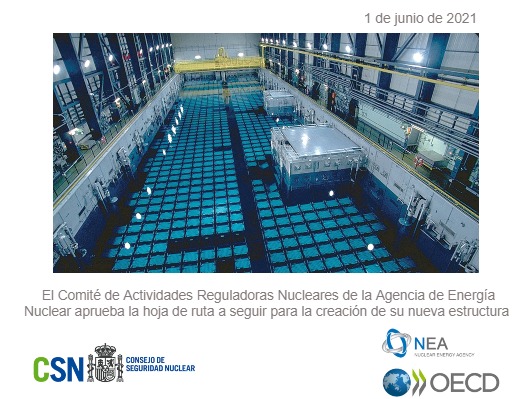Contenido principal
2021
The Committee on Nuclear Regulatory Activities (CNRA) of the Nuclear Energy Agency (NEA) approves the roadmap for the implementation of its new structure and governance

The Spanish Nuclear Safety Council (CSN) has participated in the 45th meeting of the Committee on Nuclear Regulatory Activities (CNRA) of the Nuclear Energy Agency (NEA) that took place between yesterday and today. The CSN representatives at this meeting, held virtually, were the commissioner Pilar Lucio and the director of Nuclear Safety, Rafael Cid, among other members of the regulatory body.
The Director-General of the NEA, William Magwood, during the opening of the meeting, reported on the new strategic approach of this Committee, among other relevant aspects that are expected to be addressed in future high-level meetings. In particular, Magwood highlighted the importance of risk communication activities for the nuclear regulators.
The meeting, chaired by the president of the Finnish regulator, Petteri Tiippana, has focused on the most recent activities of the CNRA and the update on the strategic review of the Committee based on the progress made since the last meeting; analysis of the vision and mission, updated functions and responsibilities for the members of the CNRA and the process of implementation of the transition period towards the implementation of the new structure and governance for the Committee. In addition to this and other elements and novelty priorities, the committee will continue to focus on facilitating the exchange of experiences and knowledge in the field of nuclear safety regulation and other cross-cutting aspects such as safety culture or public communication and participation. Finally, the CNRA restructuring proposal was approved, and is expected to be in place from January 2023.
The technical secretariat of the Committee then made a summary of the workshop that took place in December 2020 on innovative regulation and other recent developments prepared by the Division of Radiation Protection and Human Aspects of Nuclear Safety of the NEA (RP-HANS). The report on the current activities of the Committee on the Safety of Nuclear Installations (CSNI) and the report of the Regulators’s Forum (a group dependent on the waste and decommissioning committees of the NEA) was also presented.
Finally, Canada presented its study on the use of statistical methods in monitoring compliance with regulatory requirements by regulatory bodies.
Working groups’ activities
As usual, the Committee reviewed the status and proposals for activities of the various working groups dependent on the CNRA, which have adapted their work dynamics to the the virtual mode, with little effect on their planning, with the only exception of the groups whose mandates have ended before the establishment of the new structure, for which the proposals of the modality to follow were discussed, generally by integrating themselves into related groups.
The chairs of the working groups had the opportunity to present their progress and to propose new activities and reports for approval. These included proposals on good practices and procedures for the observation of inspections, by the Working Group on Inspection Practices (WGIP), among others. Among the most noteworthy, due to its coincidence with the strategic objectives of the CSN itself, the status on the “Green Booklet” project on the “Characteristics of a trusted regulator” was updated by the communication group (WGPC), co-led by the CSN; the document is planned to be presented for approval in the first half of 2022. The progress and updating of the Working Group on Safety Culture (WGSC) is also worth to be highlighted, with the promotion of a recently published report on the methods to evaluate and strengthen the safety culture of the regulatory body and the update on two new working groups; “The impact of the regulatory bodies on the organisations they oversee (and vice versa) from a safety culture perspective” and the new “Leadership” working group.
It should be noted the activity of dissemination of knowledge and good practices that the NEA promotes through the organization of workshops, courses and various training events. In this sense, the workshops planned on nuclear risk communication, organized by the WGPC and scheduled in its first edition for June 2022, and the workshop on inspection in service and aging management, scheduled by the WGCS for April 2022, were highlighted.
All CSN representatives in the working groups perform an essential function so that the CSN can maintain its contribution to the NEA's activity, which in turn allows obtaining the best returns.
Finally, the participants in this meeting discussed some relevant events which have affected the performance of regulatory functions such as the regulatory and technical issues of the Japanese Nuclear Regulation Authority (NRA) (including the cyberattack suffered by the NRA), a severe meteorological event in the United States or various passive failures events that had been selected in France, Sweden and Spain. It was agreed to schedule the next CNRA meeting in December 2021.
The CSN considers important maintaining of an active participation in all the groups of which it is part, and directly promotes activities relate to the safety culture (since the Spanish regulator is immersed in its own evaluation process) and the communication of risks to the public. Therefore, the attendance to this meeting is considered relevant and strategic, as it provides the CSN with the most valid references towards maintaining updated regulations and practices harmonized with our environment.
The CNRA is an international committee composed of representatives of the regulatory bodies of OECD member countries. It was created in 1989 to guide the NEA program on the regulation, authorization and inspection of nuclear facilities in terms of safety.
* Check here the glossary of technical terms *
